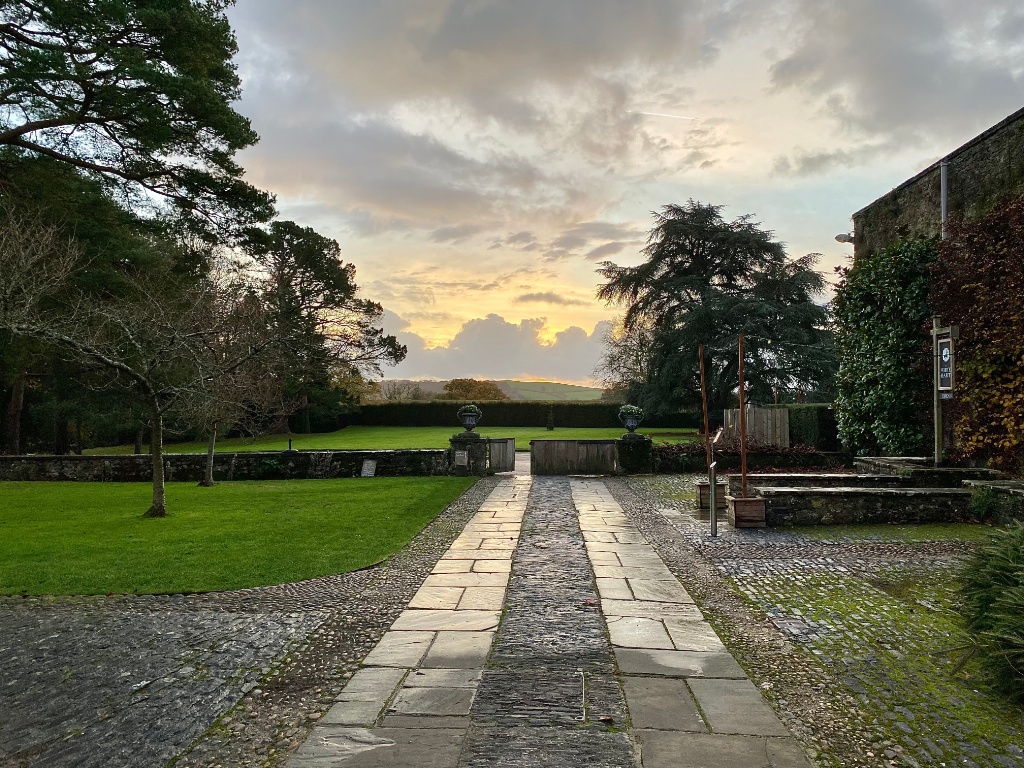Morning has broken
Early morning at Dartington Hall, where we spent the weekend (as we generally try to do whenever we’re in Devon). It’s a wonderful place, with a fascinating history which is well recounted by Michael Young in his book, The Elmhirsts of Dartington.
Quote of the Day
”The stoical scheme of supplying our wants by lopping off our desires, is like cutting off our feet when we want shoes.”
- Jonathan Swift, 1711
Musical alternative to the morning’s radio news
Bob Dylan and Joan Baez | Chimes of Freedom
Long Read of the Day
Building Fast and Slow: The Empire State Building and the World Trade Center
The astonishing story, told by Brian Potter, of how one of the modern world’s iconic buildings was constructed — on time and within budget.
The Empire State Building and the World Trade Center make for an interesting comparison. In many ways, they’re similar. They’re both iconic Manhattan skyscrapers (they were built just 3 miles apart) that sit right next to each other in the sequence of “world’s tallest building”. Both started out as projects aimed at creating (among other things) a large amount of commercial office space, and were later nudged by their owners into becoming the world’s tallest building. Both were completed in the midst of a severe economic downturn (the Great Depression and the 1973 Oil Shock, respectively), and took many years to be fully occupied. The Empire State Building would be only partially occupied through the 1930s (making money largely from visitors to the observation deck), and the owners were only saved from bankruptcy because the lender (MetLife) didn’t want the building. It wouldn’t start to turn a profit until after WWII. Similarly, the World Trade Center didn’t reach full occupancy in 1980. In both cases the building owners had to coerce government agencies to use much of the available space.
They also share an architectural genealogy – the architect of the World Trade Center, Minoru Yamasaki, had worked for several years at Shreve, Lamb, and Harmon, the architectural firm that designed the Empire State Building.
But in many ways they’re different. The Empire State Building is often the first example reached for by those nostalgic for an America that builds. Not only was it built impossibly fast by modern standards (less than a year from setting the first column to being completed), but it came in under budget, with its design becoming a widely praised example of Art Deco architecture.
The World Trade Center, on the other hand, was continuously mired in controversy and difficulty. It was slowed by lawsuits from displaced residents, political opposition from both New York and New Jersey, difficult site conditions, union strikes, and novel building systems and construction methods. From its conception in 1961 (and arguably even earlier) the project took more than 10 years to complete, going far over its planned schedule and budget.
Probably because I have an engineering background I’m a sucker for these kinds of stories. (One of my favourite books is David McCullough’s Great Bridge, a riveting account of how the Brooklyn Bridge was built.)
Alexa, how did Amazon’s voice assistant rack up a $10bn loss?
Sometimes, invasions don’t work out as well as you hoped.
Yesterday’s Observer column:
Intrigued by an Ars Technica post about Amazon’s Alexa that suggested all was not well in the tech company’s division that looks after its smart home devices, I went rooting in a drawer where the Echo Dot I bought years ago had been gathering dust. Having found it, and set it up to join the upgraded wifi network that hadn’t existed when I first got it, I asked it a question: “Alexa, why are you such a loss-maker?” To which she calmly replied: “This might answer your question: mustard gas, also known as Lost, is manufactured by the United States.” At which point, I solemnly thanked her, pulled the power cable and returned her to the drawer, where she will continue to gather dust until I can think of an ecologically responsible way of recycling her…
My commonplace booklet
What is it with so-called ‘luxury’ wristwatches? Every weekend the Financial Times’s ‘How to Spend It’ supplement is full of advertisements for analogue timepieces costing half the GNP of smallish countries. Even more puzzling: some of these watches are billed as diver’s watches, waterproof down to formidable depths and pressures. But none of their wearers known to me has ever dived deeper than the average swimming pool.
A similar thing applies to fancy ‘aviator’ timepieces. A friend wears one made by Breitling which costs over five grand, and I know for sure that he doesn’t have a pilot’s licence. He may have logged a lot of hours in the air, but all of it has been in First or Business class.
So there’s no utilitarian rationale for these watches, which basically means that they’re just male jewellery.
Errata
There were two missing links last week.
- The NYT report by Cade Metz and Ian Clontz on Tesla and the future of autonomous vehicles was here.
- The link for Nancy Sinatra’s boots was here.
Apologies for both.
This Blog is also available as a daily email. If you think that might suit you better, why not subscribe? One email a day, Monday through Friday, delivered to your inbox. It’s free, and you can always unsubscribe if you conclude your inbox is full enough already!

